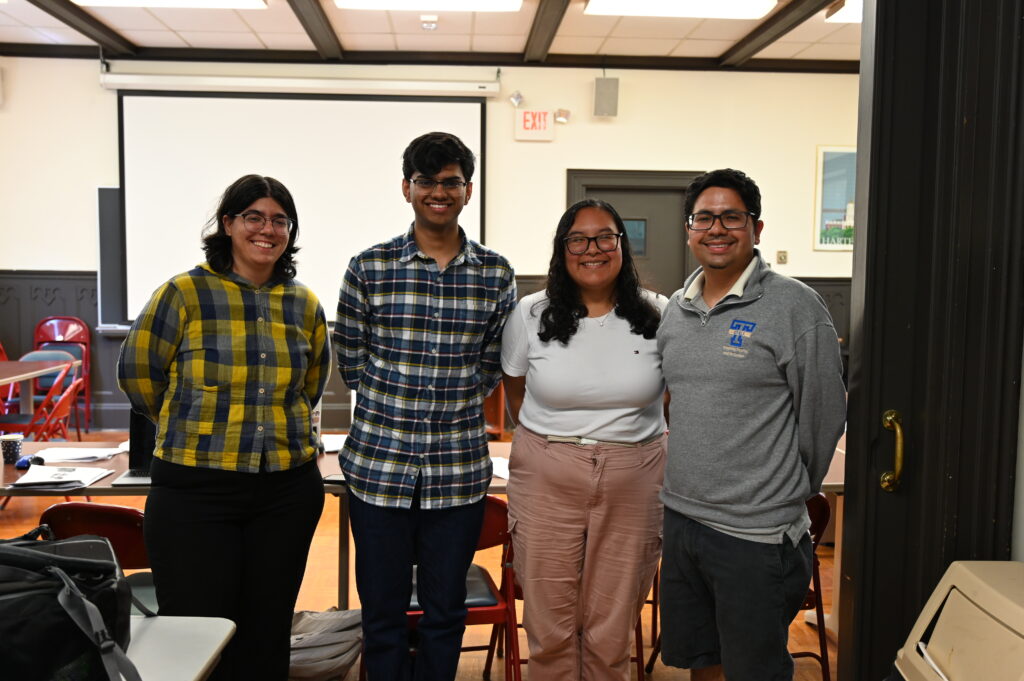Trinity Research Project Gathers Memories of Bilingual Education in Hartford
Trinity student researchers have created an online story map collecting the memories and experiences of people who received a bilingual education in Hartford over the past 60 years.
Shazif Ahmed ’26, Maria Markosyan ’26, and Mafer Vacca Crisóstomo ’27 conducted research last summer through Trinity’s Public Humanities Collaborative (PHC) with Robert Cotto Jr., the director of DEI campus and community engagement in Trinity’s Office of Diversity, Equity, and Inclusion.

The project, Bilingual Education in Hartford—Stories Over Time, includes profiles of several former students of various bilingual programs in Hartford. The Trinity students researched how the programs began, the results of the programs, and what former students said about them. “I didn’t want those memories to be lost,” Cotto said. “It’s about gathering that collective memory of what the schools were like in Hartford, to honor and understand their experiences and connect them to the present.”
Over the last half century or so, many different forms of bilingual education in Hartford resulted from local activism and national civil rights movements, said Cotto, who is teaching the course “Latinx Urban Activism since 1900” in Trinity’s Urban Studies program this semester. “This project created a timeline that highlights key examples of bilingual education in Hartford since the 1960s, with particular focus on voices remembering the schools and classrooms,” he said.
Cotto was especially interested in researching bilingual programs at Hartford schools that have closed—including Barnard-Brown School and Ann Street School—often impacting the local Puerto Rican and Latinx communities that learned in both Spanish and English. “I wanted to take some time last summer to hear stories from people who had been students at the schools and get their reflections on what that was like,” he said. “We decided to take it further and expand our research across time and the whole district, with students who learned at schools that taught in different languages.”

Among the interview subjects are several with connections to Trinity: Erna Alić, program manager in Trinity’s Center for Hartford Engagement and Research (CHER), who attended English as a Second Language (ESL) classes at M.D. Fox School; Helder Mira, multimedia producer in Trinity’s Office of Communications and Marketing, who attended an afterschool bilingual program at Parkville Community School for students from Portuguese families; and former Board of Trustees member Shakira Ramos Crespo ’02, who was part of the bilingual education program at Betances Elementary School. Cotto plans to gather additional stories to add to the project.
Last summer, the student researchers learned how Hartford has changed and grown over time, Cotto said. “They also learned how to do a public oral history, including getting permissions, recording, and transcribing—all skills that are applicable to other fields, as well,” he added.
Vacca Crisóstomo, who intends to major in political science and urban studies, identified closely with the subject of bilingual education. “As an international student from Peru, I am aware of the importance and struggles of being able to transmit my ideas in a foreign language,” she said. “I wanted to be part of this project, as it would allow me to get more immersed in the learning experiences of other bilingual students.”

Learning about the history of Hartford through the eyes of those who lived it was a highlight for Vacca Crisóstomo, who hopes to use her education to make changes in the education system of her home country.
Ahmed, of Lahore, Pakistan, said that this project aligned with his interests in public policy and community engagement and gave him the chance to explore how language, culture, and education intersect.
“Oral history projects are invaluable because they capture the lived experiences of communities often overlooked in policy discussions,” said Ahmed, who is pursuing a double major in computer science and religious studies and a minor in film studies. “This project ensures that the voices of Hartford’s bilingual community are documented and can be used to inform future educational practices and policies.”
The PHC is a component of Trinity’s Summer Research Program that brings together students, faculty and staff, and individuals and organizations in Hartford to work on public humanities—the study of how people interpret stories of our human experience.

Erica M. Crowley, director of community learning and co-director of Trinity’s PHC, said that PHC projects explore and engage with the heritage, history, and contemporary civic and cultural life of Hartford. Crowley’s fellow PHC co-director is Mary Mahoney ’09, digital scholarship strategist, and the PHC faculty liaison is Hilary E. Wyss, Allan K. Smith and Gwendolyn Miles Smith Professor of English.
“In the PHC, students are paired with faculty, staff, and community partners on projects that focus on broad humanities themes like colonization, race, religion, or migration and use methods such as oral history, archival research, digitization, or digital mapping,” Crowley said. “Through this program, students gain hands-on experience in applying humanities research methods to real-world community projects while expanding their understanding of historical and social issues.”
Crowley said that the PHC offers full-time paid research assistantships, allowing students who need to earn money during the summer to take part. She added, “This year we had a record-breaking number of student applications: 57 applicants for just 12 positions.”
Learn more about the PHC at Trinity here.
